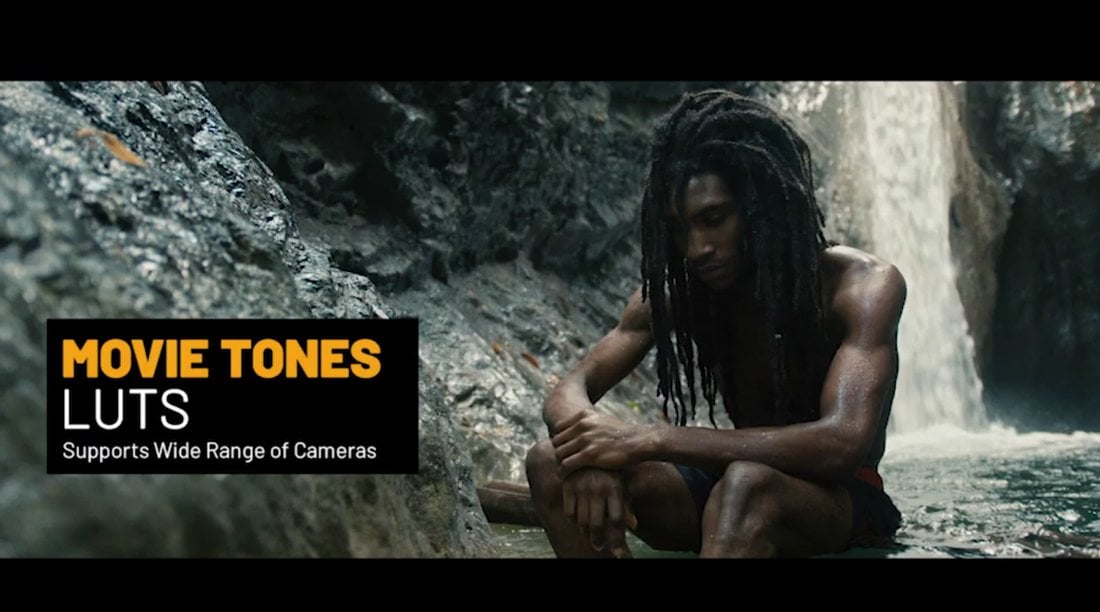Team black or team green?

Earlier this year, HBO launched an incredibly moving ad for the new season of its hit series “House of the Dragon.” It featured pictures of House of the Dragon banners in renowned landmarks globally, including The New York Stock Exchange.
Each spot vowed allegiance to a team or “house” in the series.

Image Source
The ads and buzz around the series made me go check out the show (all hail Queen Rhaenyra!). That got me thinking about ads and their impact, which eventually led me to wonder, “What is the best ad of all time?”
Now, it was a little difficult for me to come up with just one “best” advertisement of all time — which is why there are 23 in this post instead. Let’s dive in.
Table of Contents
Impactful Advertising Across the Ages
But why are these some of the best ads of all time?
Because of the impact they had on brand growth and how they hit on some universal truth that makes them memorable. In fact, some of us might not have even been alive when these campaigns first aired.
Two of the biggest challenges in advertising are measuring the value of the advertisement and ensuring it resonates with the right people.
Reaching everyone your desired customers can be tough. Your target audience are dispersed across so many different channels. Plus, the vast volume of competing ads makes it hard to stand out and make an impact on your audience.
As the nature of advertising evolves, it’s important that you do too. People can advertise anywhere, and today’s best type of ad might not be the best type tomorrow.
Types of Advertisements
As you can imagine, there are many types of advertisements — all of which run in different mediums, on different channels, and have different goals in mind for their business. Let’s see the most common ads marketers should know.
1. Print Advertising
The first print ad ran in England in 1472, according to Infolinks. Since then, this type of advertising has become unavoidable.
Print ads have run in newspapers, magazines, brochures, billboards, and flyers. In this method, the advertiser pays the publisher to place their ad in the publication.
2. Direct Mail Advertising
Direct mail involves creating and distributing printed materials to a targeted mailing list. These materials can include postcards, catalogs, brochures, letters, and promotional offers.
This method was first discovered in 1835 when the American Anti-Slavery Society (AAS) mailed print materials to southern religious and civic leaders.
Soon after, direct mail became a common advertising method used by businesses to raise awareness for their brand.
Direct mail is a tactic that should be thoughtfully deployed. I’ve received more than my fair share of junk mail that ends up directly in the trash.
However, I’ve noticed if local businesses contact me, service providers for my home reach out, or my favorite brands send coupons, I’ll keep them.
3. Radio Advertising
United States radio stations launched their first commercial broadcasts in 1920.
And while we might all drive around with our iPhones plugged in for music these days, don't let that fool you.
Radio is still a viable marketing and advertising platform today for expanding the reach of sponsored events and new products.
In this ad method, the advertiser pays the radio station to play their ad during designated breaks between music or a radio show.
4. Television Advertising
Television ads originated in the 1940s with the promotion of practical items and political campaigns. Advertisers can now use television to promote food, toys, stores, business services, and more — both to local TV channels and to national broadcast networks.
In this ad method, the advertiser pays the TV network to show their ad during designated breaks in the network's regular programming.
5. Internet Advertising
Internet advertising took root in the mid-1990s with the launch of “banner” advertisements for various telecommunications companies.
Marketers place these ads in interstitial spots on a webpage. Basically, advertisers pay the website owner to place their ads in exposed spaces peripheral to the website's own content.
But that’s just the tip of the iceberg. Internet advertising has gone on to include video, search engine marketing, and more.
6. Social Media Advertising
Social media advertising is a form of internet advertising that emerged with the introduction of social media in the 2000s.
In this ad method, advertisers promote products, services, or content through paid ads on social media platforms. That includes Facebook, Instagram, Twitter, LinkedIn, YouTube, and TikTok.
There are also many different ad formats to choose from when advertising on social media, such as image ads, video ads, carousel ads, sponsored posts, and more.
7. Mobile Advertising
Since the early 2000s, mobile advertising has been a popular method due to the widespread use of cell phones and the amount of time people spend on them.
It involves delivering promotional messages or advertisements through text messages, mobile apps, mobile websites, and push notifications.
With this method, advertisers can leverage data and create highly personalized ads based on location, behavior, and user interests.
8. Podcast Advertising
Podcast advertising gained popularity in the mid-2000s with the introduction of MP3 players, such as iPods, which made it easier for users to download and listen to podcasts on the go.
Similar to radio advertising, podcast advertising is where advertisers pay podcast owners to promote their product or service through sponsorship or ad spots in podcasts.
These ads can be inserted before, during, or after a podcast episode.
In essence, the advertising types listed above have evolved dramatically since their inception. What was once quite one-dimensional messages now carry clever, funny, or profound undertones that make the ads memorable for years to come.
After reading Jennette McCurdy’s memoir about her life as a child star, I tuned into her podcast “Hard Feelings.” The ad breaks in her show were witty, showcasing her personality.
In one, she takes a bite out of a Hello Fresh lettuce wrap, and you can hear the crunch. Memorable, indeed!
What makes a good advertisement?
No matter which method of advertising you use, one thing remains true: The best advertisements capture the attention of consumers right from the start.
I asked 10 advertising and marketing professionals what makes an ad stand out to them. This is what they said.
1. Clear and Consistent Messaging
“Memorable ads stick in your mind often due to consistent branding. When everything from the colors to the messaging aligns seamlessly, it builds a strong identity. This familiarity breeds trust and recognition,” says Cesar Cobo, chief operating officer at Webris.
Clear messaging ensures that your audience understands what you’re trying to communicate with them. Without clarity, consumers may misinterpret or fail to grasp the main point of your ad, leading to confusion and a loss of impact.
Beyond that, “A consistent brand message across all platforms ensures that your audience can easily recall who you are, even amidst a sea of competitors. Craft a bold and clear message that cuts through the noise,” Cobo notes.
As consumers are constantly bombarded with advertisements, simple and straightforward messaging can also help your brand cut through the noise and grasp their attention.
2. Storytelling
“The most impactful ads don't just sell a product — they tell a story that resonates with the viewer. An ad that can genuinely make you laugh, touch your heart, or inspire you in some way has a much better chance of sticking in your mind,” says Will Yang, head of growth and marketing at Instrumentl.
I wholeheartedly agree. Extra Gum made one of my all-time favorite commercials.
In it, a dad folds paper cranes out of gum wrappers for his daughter as she grows up. Before she moves away to college, he finds that she’s saved all of the origami cranes he’s made her. Just thinking about the ad makes me tear up.
Storytelling is essential in advertising because it allows you to connect with your audience on a deeper level.
A well-told story has the potential to hold your audience’s interest for longer, increasing the chances of delivering your message more effectively.
Telling a story can also help you differentiate your brand from competitors. By sharing unique stories that reflect your brand’s values or mission, you can establish a distinct brand identity and develop a loyal customer base.
"At the end of the day, people don't buy products; they buy stories,” Yang reminds.
3. Emotional Appeal
Emotions are a fundamental part of the human experience. I get emotional when my favorite character in a show cries or when I order takeout that isn’t as good as I thought it would be.
When advertisements appeal to emotions, they tap into universal feelings, such as joy, sadness, or empathy. This creates a sense of relatability and empathy, allowing viewers to connect with the brand on a deeper level.
“If an ad makes you laugh, you remember it, if an ad makes you angry, you‘ll remember it. If an ad reminds you of your childhood, you’ll certainly remember it.
You remember how you feel, and you associate that with the product or service,” says Brandon Gilliam, head of marketing and sales at Happy Grub.
Keep in mind that it‘s important to strike the right balance in emotional appeals and ensure authenticity and relevance to the brand and its target audience.
Emotions should be used ethically, responsibly, and in alignment with the brand’s values and positioning.
4. Building Memories
Whether your ad has a unique tagline or a load of humor, a uniquely creative approach has the power to stick with peoples’ minds and give you a competitive advantage in the crowded advertising landscape.
When I asked what makes an ad memorable to him, Casey Meraz, the CEO of Juris Digital, notes, “Surprising elements can really make an ad stick. A twist on something expected grabs attention and leaves a lasting impression.”
Meraz recalls Geico’s “Hump Day” ad. In it, a camel walks through the office asking workers to “guess what day it is.” (It was, in fact, hump day).
“The unexpected camel in an office setting broke through the usual noise. When an ad surprises, it disrupts the monotony and resonates on a deeper level, Meraz says.
When an advertisement leaves a strong impression, it continues to influence consumers. Memorable ads are also more likely to be shared and generate word-of-mouth, amplifying their reach and impact.
My personal example? Mountain Dew’s bizarre monkey-puppy-baby ad, where a slightly horrifying hybrid creature walks into the room with a bucket of soda cans.
To this day, I’m not sure if I liked the ad. But I did talk about it when it came out, and the monkey-puppy-baby haunts my dreams to this day.
5. Strategic Repetition
The key to effective advertising lies in consistent messaging. One of the things I did when I first started out as the owner of a clothing brand was to craft consistent ads across platforms.
This strategic repetition promotes a sense of familiarity with the brand and its core message.
The goal isn't to bombard viewers with your content but rather to create a cohesive experience that resonates across different platforms.
This nurtures an environment for message reception, which leads to a more memorable brand experience for your audience.
Peter Hoopis, owner of Hoopis Pickleball, notes that this is where a multi-channel approach comes in.
“Each element, from video to social media, presents a unique piece of information, yet all contribute to a central theme. This consistency builds a narrative and reinforces the message with each iteration,” Hoopis says.
6. Music
Bah da, buh, buh, buh… Now, you fill in the blank. This would be much easier to convey if I were actually sitting in a room with you, but some of you may have answered correctly. “I’m lovin’ it.”
Laia Quintana, head of marketing and sales at TeamUp, brings up the tune when discussing the power of music in ads.
“The jingle‘s catchy melody and simple lyrics create instant brand recognition and recall. This combination of music and message has made the ad timeless — every time I hear that jingle, I instantly think of McDonald’s,” Quintana says.
Everyone loves a catchy tune. Music is one of the easiest ways to evoke emotions and aid recall. People tend to remember good music, so including this element in your ad will definitely add to its appeal.
7. Striking Imagery
Let’s talk visuals! Humans are very visual creatures. Just looking at a delicious meal is enough to make you salivate, and the face of Rhaenyra Targaryen in The House of the Dragon makes viewers want to bend the knee.
Darija Grobova, a team lead for public relations at Omnisend, shares another example from the soccer realm.
“The powerful visuals of the Orange-France women’s National Football Team ad of 2023 stands out in this regard.
Using VFX, they made the female players initially look like their male counterparts, driving home a powerful message: when Orange supports the men’s team, they’re also supporting the women’s team,” Grobova says.
The real kicker (pun intended)? The visuals of the athletes.
“The use of real footage of athletes created a strong emotional connection and overturned one of the prejudices that all too often surround the players,” Grobova notes.
How your ad looks contributes to its success. Thanks to technology, there is so much you can do to play with your ads’ visuals now.
8. Prompting Action
A good ad creates a sense of urgency and prompts the audience to take action, whether it’s to make a purchase, visit a website, sign up for a newsletter, or engage with the brand in a meaningful way.
A clear call to action guides your audience on what steps they should take next.
Ultimately, prompting action ensures that advertisements are not just passive messages but active drivers of business outcomes.
So how do you create an advertising strategy that resonates? Well, this post should help with that as we explore how we can learn from ads and campaigns.
But, first, an important distinction.
An advertising campaign is a group of similar ads with a unified tone or message.
The advantage of a campaign over a standalone ad is the ability to push the same idea in different ways, across multiple mediums, and for a longer period of time without getting too repetitive or stale for the audience.
-1.webp?width=350&height=456&name=Copy%20of%20Copy%20of%20Track%20All%20of%20Your%20Marketing%20Data%20in%20One%20Convenient%20Place%20(17)-1.webp)
Download for Free
Use HubSpot's free Advertising Campaign Kit to plan out your advertising project and learn more about which advertising type is the best for your project.
The Best Advertisements of All Time
Without further ado, here they are in no particular order: 24 of the best advertisements of all time and the lessons we can learn from them.
1. Nike: Just Do It.
Ad Campaign: Print, Television, Internet
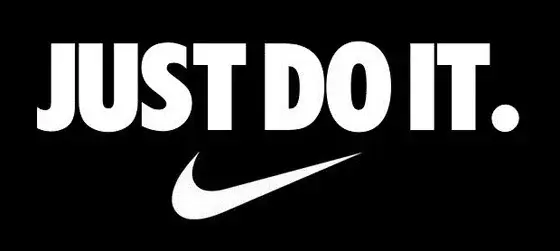
Image Source
Did you know that once upon a time, Nike‘s product catered almost exclusively to marathon runners?
Then, a fitness craze emerged, and the folks in Nike’s marketing department knew they needed to take advantage of it to surpass their main competitor, Reebok.
(At the time, Reebok was selling more shoes than Nike). And so, in the late 1980s, Nike created the “Just Do It.” campaign.
It was a hit.
In 1988, Nike sales were at $800 million; by 1998, sales exceeded $9.2 billion.
“Just Do It” was short and sweet yet encapsulated everything people felt when exercising — and people still feel that feeling today.
Don‘t want to run five miles? Just Do It. Don’t want to walk up four flights of stairs? Just Do It. It's a slogan we can all relate to: the drive to push ourselves beyond our limits.
The Lesson
When you‘re trying to decide the best way to present your brand, ask yourself: what problem are you solving for your customers? What solution does your product or service provide? By hitting on that core issue in all of your messaging, you’ll connect with consumers on an emotional level that is hard to ignore.
2. Coke: Share a Coke
Ad Campaign: Print
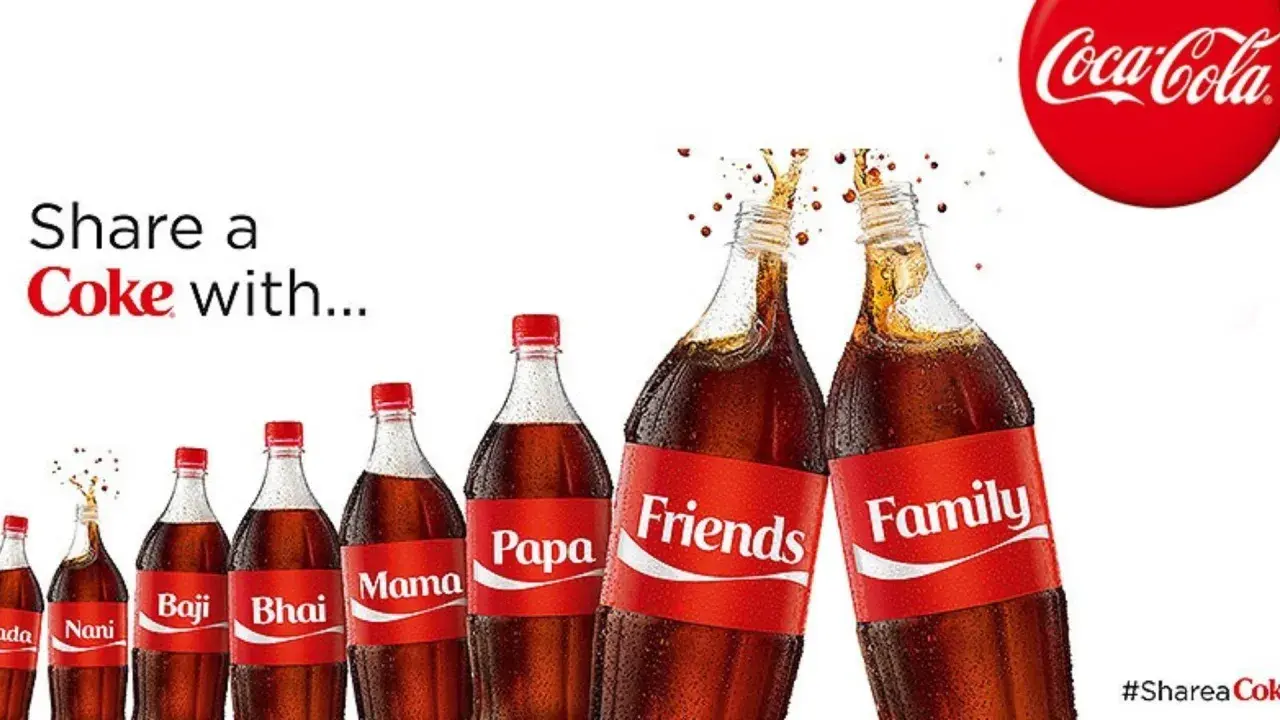
Image Source
Big brands are often hard-pressed to do something ground-breaking when they're already so big. So, what did Coca-Cola do to appeal to the masses? They appealed to individuals by putting their names on each bottle.
The Share a Coke campaign began in Australia in 2011 when Coca-Cola personalized each bottle with the 150 most popular names in the country.
Since then, the U.S. has followed suit, printing first names across the front of its bottles and cans in Coke's branded font. You can even order custom bottles on Coke's website to request things like nicknames and college logos.
This was a breaking story across the marketing and advertising industry. It enchanted many consumers, but it confused others. Why make something temporary so personal?
Either way, Coke received immediate attention for this campaign.
Pepsi even released some sassy counter-ads shortly after the campaign launched. Theirs focused on mocking the bottle names, questioning how people truly felt when they got the wrong name.
The Lesson
Coke fans are regular buyers, and the company fully leaned into that sense of individual ownership. Wondering what name you’ll get out of the vending machine was a fun thrill in and of itself — even if it isn’t yours, it encourages you to “share a Coke” with whoever's name is on the front.
3. Absolut Vodka: The Absolut Bottle
Ad Campaign: Print
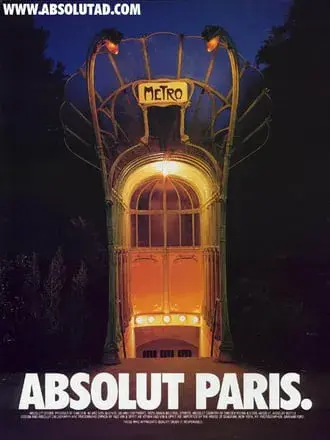
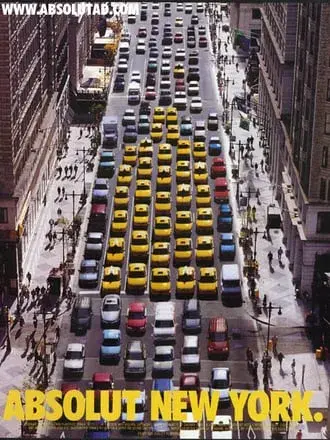
Image Source
Despite having an ambiguous shape, Absolut made its bottle the most recognizable bottle in the world. Its campaign, which featured print ads showing bottles “in the wild,” was so successful that it didn‘t stop running for 25 years.
It’s the longest uninterrupted ad campaign ever and comprises over 1,500 separate ads. So, as the saying goes, “If it ain‘t broke, don’t fix it.”
When the campaign started, Absolut had a measly 2.5% of the vodka market.
When it ended in the late 2000s, Absolut was importing 4.5 million cases per year, or half of all imported vodka in the U.S.
The Lesson
No matter how boring your product looks, you can still tell your story in an interesting way. Let me repeat: Absolut created 1500 ads for one bottle. So, don’t feel afraid to be determined and differentiate your product in the same way.
4. Anheuser-Busch: Whassup (1999)
Ad Campaign: Television
When's the last time an advertisement literally changed the way we talk to one another? Allow me to answer that question with another question: “Whassup?!”
This series of commercials, which first appeared in late 1999, features a group of friends connecting on a group phone call (not very common anymore, huh?) while drinking beer and “watching the game” on TV.
It starts gently: “What are you doin‘?” Someone asks. “Watching the game, havin’ a Bud” (a Budweiser), someone replies.
As more friends pick up the phone, hilarity ensues: “WHASSUP!?” is yelled back and forth, becoming a classic catchphrase and an icon of beer-drinking culture that constantly ran on sports networks over the next few years.
The Lesson
The ad took pop culture by storm during the Super Bowl in 2000, and you can still hear its echoes today. Why? Anheuser-Busch showed us just how silly and informal an ad can be without ruffling feathers or going off-brand.
Dare to celebrate your audience's absurdities. The more genuine your ad is, the more valuable your product is.
5. Miller Lite: Great Taste, Less Filling (1974)
Ad Campaign: Print, Television

Image Source
Think it's easy to create a whole new market for your product?
The Miller Brewing Company (now MillerCoors) did just that with the light beer market — and dominated it.
The goal of the “Great Taste, Less Filling” campaign was getting “real men” to drink light beer, but they were battling the common misconception that light beer can never actually taste good.
Taking the debate head-on, Miller featured masculine models drinking their light beer and declaring it great tasting.
The Lesson
For decades after this campaign aired, Miller Lite dominated the light beer market it had essentially created.
What‘s the lesson marketers can learn? Strive to be different. If people tell you there isn’t room for a product, create your own category so you can quickly become the leader.
6. Always: #LikeaGirl (2015)
Ad Campaign: Television, Internet
Always, the feminine product brand, hit a home run with this advertisement.
That's not because it went viral after the commercial ran in the 2015 Super Bowl, but because it was a groundbreaking message that hundreds of millions of people repeated long after the campaign was over.
The campaign began as a commercial explaining the stigma behind playing sports “like a girl” — implying that the boy‘s way is better or correct.
By the end of the ad, the message is both clear and inspiring: girls are just as fit and capable as boys are, particularly during puberty — a stage of life that’s extremely important to Always and its women’s products.
The message is now a holistic initiative by Always and a hashtag that's still used on social media today.
The Lesson
Acknowledge not just your audience but the challenges they face—especially the ones that reflect your time or culture. Not every societal issue is off-limits to marketers and advertisers. Take a stand on the ones you know your audience supports, and you'll access a customer base that identifies with your passion.
7. Volkswagen: Think Small (1960)
Standalone Ad: Print
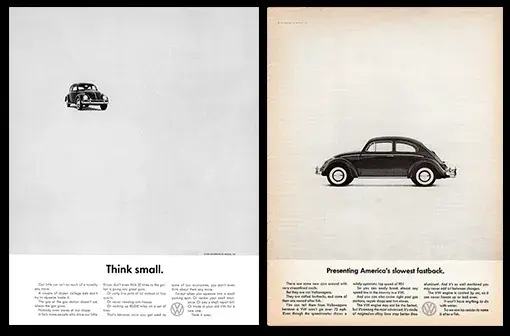
Image Source
Many marketing and advertising professionals like to call Volkswagen‘s “Think Small” campaign the gold standard.
Created in 1960 by a legendary advertising group at Doyle Dane & Bernbach (DDB), the campaign set out to answer one question: how do you change people’s perceptions not only about a product but also about an entire group of people?
See, Americans always had the propensity to buy big American cars—and even 15 years after WWII ended, most Americans were still not buying small German cars.
So what did this Volkswagen advertisement do? It played right into the audience‘s expectations. You think I’m small? Yeah, I am. They never tried to be something they weren’t.
The Lesson
That‘s the most important takeaway from this campaign: don’t sell your company, product, or service as something it's not. Consumers recognize and appreciate honesty.
8. Google: Year in Search (2017)
Ad Campaign: Internet
This isn‘t the oldest or most well-known advertisement on our list, but it’s become the most powerful over its nine-year (and still ongoing) existence. So powerful and so true you forget it's an advertisement.
Year in Search began in 2009 as “Zeitgeist,” a written report of the public‘s most common Google searches over the previous 12 months. The following year, Google adapted it for a three-minute video.
Since then, it’s been a bold, yearly reminder of how much we depend on Google for information on the news and events that give the entire world pause. Check out the company's latest video from 2021 above.
The Lesson
Remind your customers how much you care that they care. These stories elicit a variety of emotions but ultimately unite everyone — no matter what Google products they might like — through an uplifting message of how our usage of the company reflects the best in all of us.
9. Dos Equis: The Most Interesting Man in the World (2006)
Ad Campaign: Television, Pre-roll
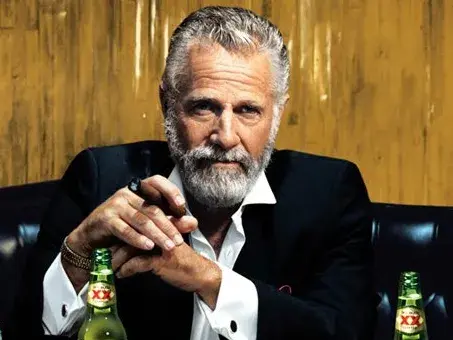
Image Source
You know who he is. The man smokes Cuban cigars, surrounds himself with beautiful women, and drinks Dos Equis beer.
Cooling down indulgent vices, such as beer, desserts, or luxury items, is key to creating a successful campaign. And The Most Interesting Man in the World is one of the coolest commercial guys out there.
At the end of every commercial, he says: “I don't always drink beer, but when I do, I prefer Dos Equis. Stay thirsty, my friends.”
The Lesson
The hilarious hyperbole employed in this campaign makes it memorable the next time viewers head out to buy some beer.
And even though Dos Equis recently replaced The Most Interesting Man with a new actor, the original actor’s popularity in meme culture will never decline because of his short, sweet, and memorable tagline — and the cool dude vibe it makes viewers harken back to.
10. California Milk Processor Board: Got Milk? (1993)
Ad Campaign: Print
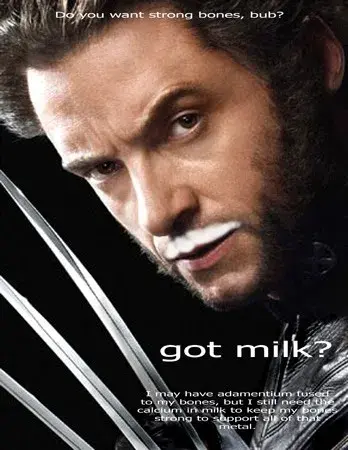
Image Source
Thanks to the California Milk Processor Board's “Got Milk?” campaign, milk sales in California rose 7% in just one year.
But the impact ran across state borders, and to this day, you still can't escape the millions of “Got [Fill-in-the-Blank]?” parodies.
Note, though, that the ad didn‘t target people who weren’t drinking milk; it instead focused on the consumers who already were.
The Lesson
It‘s not always about getting a brand-new audience to use your products or services. Sometimes, it’s about getting your current audience to appreciate and use your product more often.
Turn your audience into advocates, and use marketing and ad content to tell them why they should continue enjoying the product or service you’re already providing.
11. Metro Trains: Dumb Ways to Die (2012)
Ad Campaign: Internet, Radio
Yes, you read that right: Dumb Ways to Die.
In Melbourne, Australia, Metro Trains wanted to convey a simple message: no horsing near train tracks. Disorderly conduct could lead to injuries or even death.
Still, instead of typical warning signs or announcements inside train stations, Metro Trains came up with Dumb Ways to Die, a song that has garnered 157 million YouTube views since it debuted in 2012.
The song is, unsurprisingly, about dumb ways to die. For example, poking a grizzly bear with a stick or taking your helmet off in outer space.
Frankly, it features a catchy little chorus you won't be able to stop humming to yourself (because singing it is a little morbid): “Dumb ways to die, so many dumb ways to die.”
At the end of the video, after you've watched adorable cartoon characters dying in the dumbest of ways, you get to the moral of the story:
There are many dumb ways to die, but the dumbest possible way would be if you died while standing on the edge of a train platform, drove through a railroad sign, or tried to cross over a train track.
The video ad went viral on YouTube. The song was available on iTunes and even played over the radio with an accompanying ad.
The Lesson
This beloved, now-famous campaign communicates a simple idea in a creative and memorable way — and you don‘t feel you’re being nagged the way some public service announcements do. Consider using creativity to convey your message if your subject matter is grim or boring.
12. Apple: Get a Mac (2006)
Ad Campaign: Television
While there have been many great Apple campaigns, this one takes the cake. The video above is just one of a series of iterations of this campaign, and the Mac vs. PC debate ended up being one of the most successful campaigns ever for Apple.
The company experienced 42% market share growth in its first year with its help. These commercials tell Apple's audience everything they need to know about the product without being overt.
The Lesson
Just because your product does some pretty amazing things doesn‘t mean you need to hit your audience over the head with it. Instead, explain your product’s benefits in a relatable way, so consumers can see themselves using it.
13. Clairol: Does She or Doesn't She? (1957)
Standalone Ad: Print
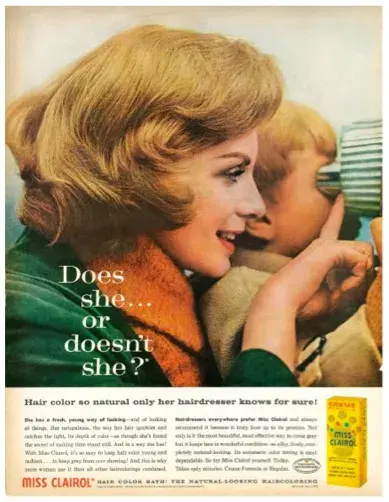
Image Source
The first time Clairol asked this question in 1957, the answer was 1 to 15 — as in, only 1 in 15 people were using artificial hair color. Just 11 years later, the answer was 1 of 2, according to TIME Magazine.
The ad was apparently so successful that some states stopped requiring women to denote hair color on their driver’s licenses. You know you’ve hit a nerve when your ad campaign changes things at the DMV.
Clairol did the opposite of what most marketers would do: they didn‘t want every woman on the street running around saying they were using their product.
They wanted women to understand that their product was so good that people couldn’t tell if they were using it or not.
The Lesson
Sometimes, simply conveying how and why your product works is enough for consumers. Showing becomes more effective than telling.
14. De Beers: A Diamond is Forever (1999)
Ad Campaign: Print, Television
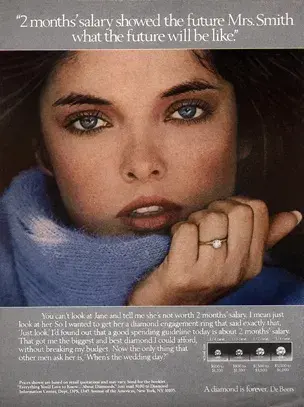
Image Source
In 1999, AdAge declared De Beers’ “A Diamond is Forever” the most memorable slogan of the twentieth century.
But the campaign, which proposed (pun very much intended) the idea that no marriage would be complete without a diamond ring, wasn’t just riding on the coattails of an existing industry.
De Beers actually built the industry. It presented the idea that a diamond ring was a necessary luxury.
According to the New York Times, N. W. Ayer’s game plan was to “create a situation where almost every person pledging marriage feels compelled to acquire a diamond engagement ring.”
The Lesson
Advertising can make a relatively inexpensive product seem luxurious and essential.
15. Old Spice: The Man Your Man Could Smell Like (2010)
Ad Campaign: Television, Internet
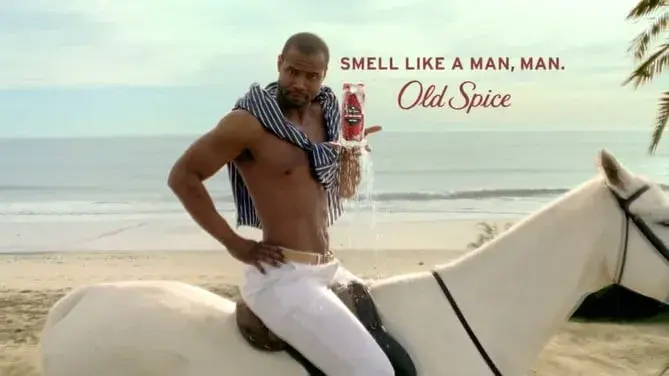
Image Source
The very first part of Old Spice's “The Man Your Man Could Smell Like” campaign, created by Wieden + Kennedy and launched in February 2010, was the following commercial. It became a viral success practically overnight:
That video has over 51 million views as of this writing. Several months later, in June 2010, Old Spice followed up with a second commercial featuring the same actor, Isaiah Mustafa.
Mustafa quickly became “Old Spice Guy,” a nickname Wieden + Kennedy capitalized on with an interactive video campaign in which Mustafa responded to fans' comments on Facebook, Twitter, and other social media websites with short, personalized videos.
In about two days, the company had churned out 186 personalized, scripted, and quite funny video responses featuring Mustafa responding to fans online.
According to Inc., these videos saw almost 11 million views, and Old Spice gained about 29,000 Facebook fans and 58,000 new Twitter followers.
“We were creating and sending miniature TV commercials back to individual consumers that were personalized, and we were doing it on a rapid-fire basis,” Jason Bagley, former creative director at Wieden + Kennedy and a writer for the campaign, told Inc.
“No one expects to ask a question and then be responded to. I think that's where we broke through.”
The Lesson
If you find your campaign‘s gained momentum with your fans and followers, do everything you can to keep them engaged while keeping your messaging true to your brand’s voice and image.
16. Wendy’s: Where’s the Beef? (1984)
Ad Campaign: Print, Television

Image Source
Is it enough to say this campaign was successful because it featured a giant hamburger bun and a cute set of old ladies? No? I didn't think so.
Wendy‘s took a more daring approach in this advertising campaign: it targeted its competitors. The simple phrase “Where’s the beef?” was used to point out the lack of beef in competitors‘ burgers — and it quickly became a catchphrase that encapsulated all that was missing in their audience’s lives.
While you can't predict when a catchphrase will catch on and when it won‘t, Wendy’s (wisely) didn't over-promote their hit phrase. The campaign only ran for a year, allowing it to gently run its course.
The Lesson
Be careful with your campaign successes and failures. Just because you find something that works doesn’t mean you should keep doing it repeatedly to the point it’s played out. Allow your company to change and grow, and you may find that you can have even greater success in the future by trying something new.
17. Procter & Gamble: Thank You, Mom (2012)
Ad Campaign: Television
Seriously, you wouldn‘t expect a household and cleaning products company commercial to pull at the heartstrings like that, would you?
Lately, though, Procter & Gamble (P&G) has launched some of the best ads we’ve ever seen from the consumer goods industry.
That's because P&G identified the story behind the story of Olympic athletes — the stories of the supportive moms who pushed these world-class athletes throughout their entire lives leading up to that crowning moment.
And yes, they probably had to do a lot of laundry and cleanup along the way (presumably using P&G products).
The Lesson
Make your audience cry (just kidding). The season or time period of your ad is important. But even if you run an ad during the Olympic Games, like P&G did, make sure it has longevity and a message that can influence people no matter when or where they see it.
Emotional and nostalgia marketing are powerful tactics to get people to make buying choices, so if there's a bigger, more universal story behind your product or story, tap into it — and showcase it front and center.
18. KFC: “FCK” (2018)
Standalone Ad: Print
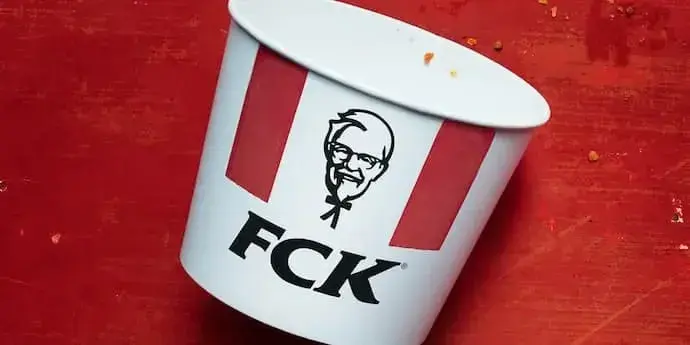
The ad above isn‘t just an empty bucket of KFC with the company’s letters jumbled around. It's also not a normal, unprompted promotion of fried chicken.
This ad is an apology and perhaps the most creative one of all time.
In February 2018, KFC's business in the U.K. ran out of chicken. You read that right: a poultry company ran out of poultry.
It‘s not every day that a business stumbles upon the most ironic PR crisis in company history, so when it happens, all eyes are on the business’s response. Well, we're happy to report that KFC stuck the landing.
With the help of the creative agency Mother London, KFC took out a full-page ad in Metro, the U.K.'s newspaper, rearranging its three famous initials to create a hilarious, albeit explicit, response to its product shortage.
The ad depicts a KFC bucket that reads, “FCK” — as if to say, “FCK, this is embarrassing.” (You can fill in the missing letter ... )
Beneath this design, the company apologizes for what it realizes is an inexcusable, if not slightly funny, failure.
The Lesson
No business is above a good old-fashioned sorry. And if you can laugh at yourself in the process, you‘ll only make it better. KFC’s ad shows how to combine humility, class, humor, and ultimately company pride in a message that can help you bounce back from the bad press ...
... and even come out the other side with a net-positive result for your brand.
19. Cartier: “Panthère de Cartier” featuring V (Kim Taehyung) (2023)
Ad Campaign: Print, Internet

Image Source
When wandering into the waters of K-pop, I learned a few things early on: 1) do not ever question somebody’s bias, and 2) don’t ever underestimate the BTS army.
Cartier learned these lessons too, bringing them into this partnership with V, one of BTS’ members.
The ad creates a disruptive and memorable impact by blending high fashion with celebrity influence, using V‘s global popularity to draw attention.
The ad’s aesthetic sophistication and strategic use of a high-profile ambassador all contributed to its standout nature, capturing viewers’ attention and leaving a lasting impression.
It was reported that The Cartier Panther Necklace 18k Yellow Gold sold out within minutes on the luxury brand website after it was announced that Kim Taehyung became their brand ambassador and was shown wearing it in recent viral pictures.
The Lesson
Influencer marketing can work if the image and brand of the influencer matches that of the brand. In this case, Kim Taehyung’s elegance and charisma perfectly align with Cartier's luxurious image, making the ad both captivating and influential among a broad audience.
20. Nike: “You can’t stop us” (2020)
Ad Campaign: Internet
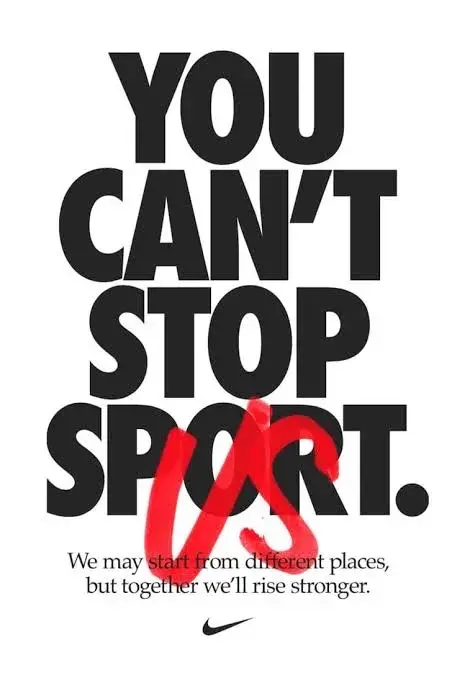
Image Source
Nike has always been known for its innovative and inspiring marketing campaigns, such as “Just Do It” (seen earlier on this list).
“You Can’t Stop Us” is a campaign that celebrates the return of sports after the pandemic. The ad is a video montage of athletes from different sports and backgrounds, highlighting the resilience and diversity of the sports community.
The video, which was released in July 2020, has been viewed over 100 million times on YouTube and has won several awards, including a Grand Prix at Cannes Lions.
The Lesson
Cultural relevance, inclusivity, and diversity are some factors that make up a great ad. Nike used all three, including music, narration, and powerful imagery at a time when the world was adjusting to a new reality, which made this ad a hit with customers.
21. Dove: “Real Beauty Sketches” (2023)
Ad Campaign: Internet
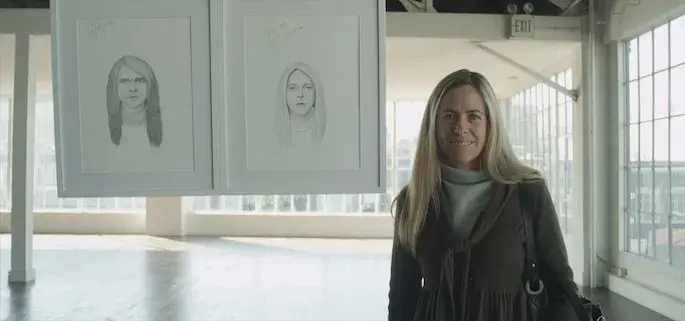
Image Source
If someone asked you to describe yourself, what would you say?
More than half of women globally agree that when it comes to how we look, we might be our own worst critic. Our perception of ourselves is far less positive than it should be. Our beauty standards can be too exacting.
The ad addressed this issue by featuring an FBI-trained forensic artist who drew two sketches of several women — one based on their own description and another based on a stranger’s description.
The difference between the two sketches was striking and it beautifully conveyed the message that we are more beautiful than we think.
This ad was disruptive because it challenged the traditional beauty standards set by the industry. Instead of using models with perfect features, Dove chose to highlight the beauty of everyday women.
What made this ad great was its emotional impact. It resonated with women around the world who could relate to the feeling of being too hard on themselves.
The ad was not just selling a product. It was promoting a positive self-image, and that’s what made it stand out.
The Lesson
The success of this ad lies in its authenticity and its ability to connect with the audience on a deeper level. This is a great example of how advertising can be used to not just sell products but also to promote positive social change.
22. Just Eat: “Did Somebody Say” (2023)
Ad Campaign: Internet
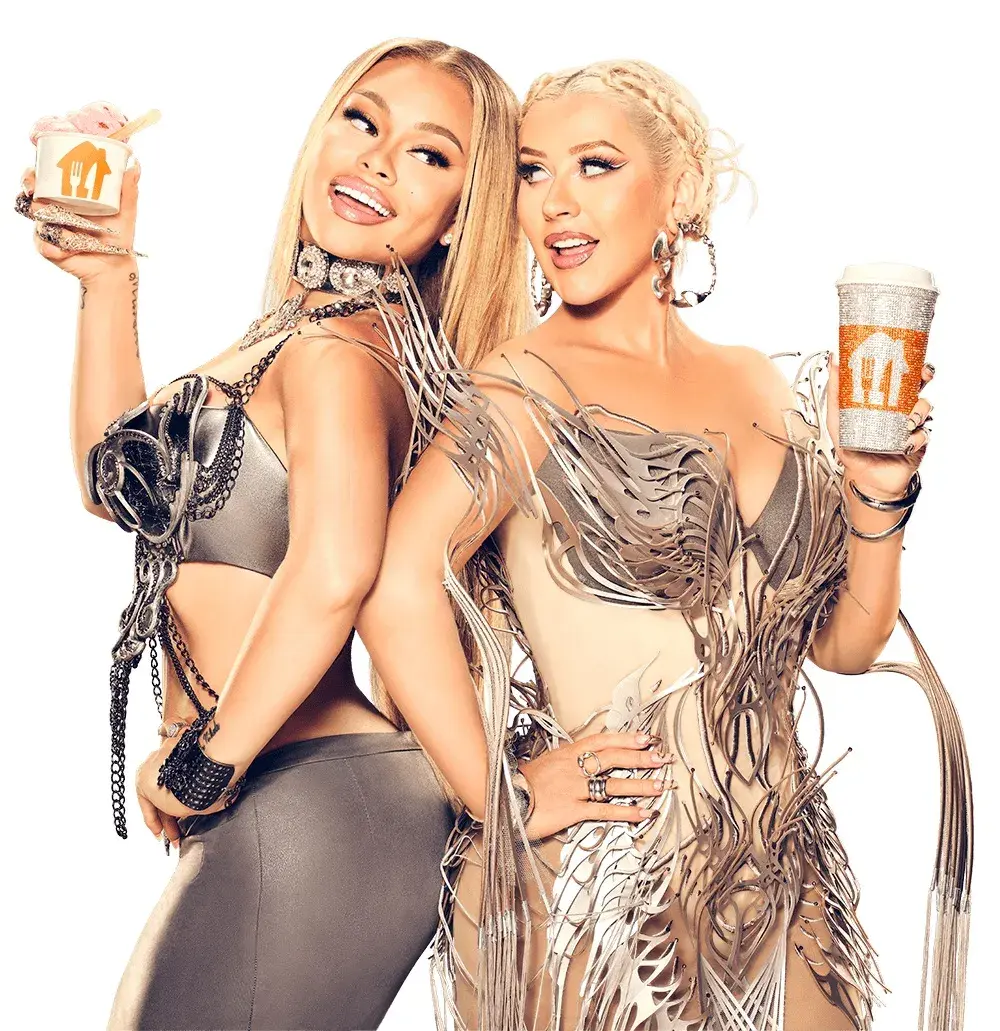
Image Source
“Ohm you thought it was just burgers and fries? They got more flavors than you tasted or you heard in your life. Ooh — this is what the app do, it ain’t only fast food. Switching styles like opera to rap too.”
This ad was an unexpected visual and musical delight. Using a hilarious mix of opera and hip hop, Just Eat released a beautiful music video with stunning visuals featuring Christina Aguilera and Latto just belting out praises for the U.K. delivery brand. The ad quickly went viral on social media, boosting brand awareness.
The Lesson
Like I said earlier, music can be a powerful way to convey your brand message in an ad and make it memorable. I saw this ad last year on TikTok, and till today I can still hear Christina belt “Thai rice, sticky icky” in my head.
23. Snickers: “You are not you when you’re Hungry” (2008)
Ad Campaign: Television, Internet
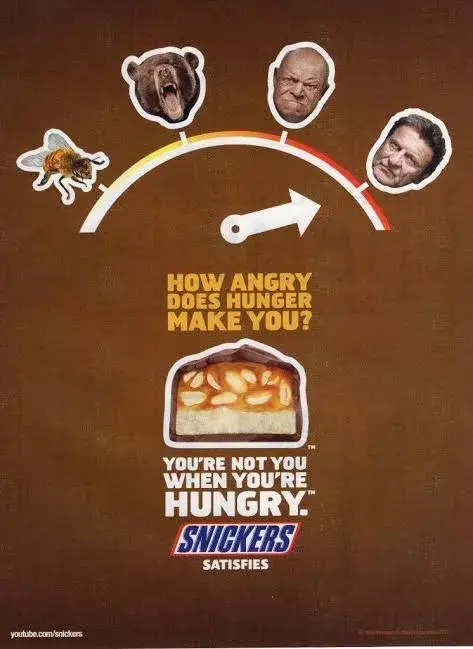
Image Source
In 2007 growth for Snickers lagged behind other global chocolate brands and they started losing market share. Projections showed that if it remained on the same trajectory, the brand would lose its position as the world’s leading chocolate bar.
They needed fame and more customer engagement. Fast.
To make this ad, they tapped into a core human experience: hunger. The impact was almost instant, increasing the sales of Snickers to $376 million globally.
This ad also generated 400 million incremental and unpaid media impressions with a media value equal to $28.6 million, making Snickers famous.
The Lesson
When making an ad, finding something that you core audience relates to is essential. People eat chocolate bars for lots of different reasons, but the main outcome that they want is satisfaction. Snickers realized this and factored that into their ad, making it relatable.
24. Charli xcx: “Brat” (2024)
Ad Campaign: Internet, Location-based Advertisement

Image Source
If you’ve been online, you know that 2024 is the year of brat summer, a reference to pop star Charli xcx’s sixth studio album. The branding for the record itself: the word “brat” in stretched-out Arial font over a bright green background.
The album’s simple visual identity made making user-generated content a breeze. TikTokers make lists in the same font proclaiming what is Brat (sunglasses in the club) and what is not (being self-conscious on the dance floor).
The simple X endorsement “kamala IS brat” was enough to have the candidate’s social team redesign their social branding in the same Brat green.
I could write a dissertation about the marketing behind the album. But, let’s get specific and talk about the Brat wall. Buckle up for some lore.
A few days before the album dropped, a wall in Williamsburg’s was painted lime green. When the album came out the phrase “i’m your fav reference” was added, lyrics from one of the album’s songs.
The wall continued to change. It was painted white with the phrase “brat and it’s the same but there’s three more songs so it’s not” to signal that a deluxe addition of the album would soon drop. The wall proclaimed “lorde” when a remix with the New Zealand singer was dropped.
In short, the wall went viral, like the album and the singer herself.
The Lesson
Brat showcases the power of cohesive branding. A simple color and text pairing took the internet by storm. Fans turned to a literal wall, decoding it for messages about what would happen next. I appreciate how Charli’s team harnessed the power of simplicity to build hype.
Use these advertisement examples to inspire your own ads.
Advertising is one of the most important aspects of any business, and it can be a make-or-break factor in terms of success.
What makes a great advertising campaign? It must be memorable, catchy, and above all else, it must effectively sell your product or service.
With careful planning and execution, your next advertising campaign could be the one that takes your business to new heights. Good luck!
Editor's note: This post was originally published in January 2019 and has been updated for comprehensiveness.


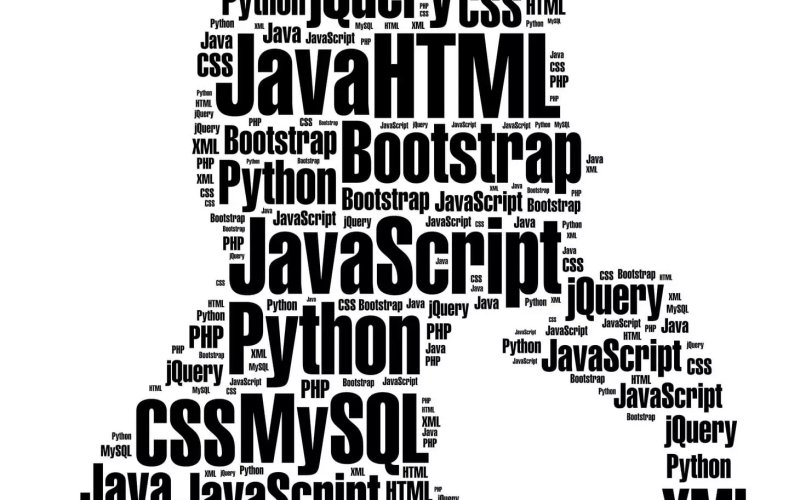


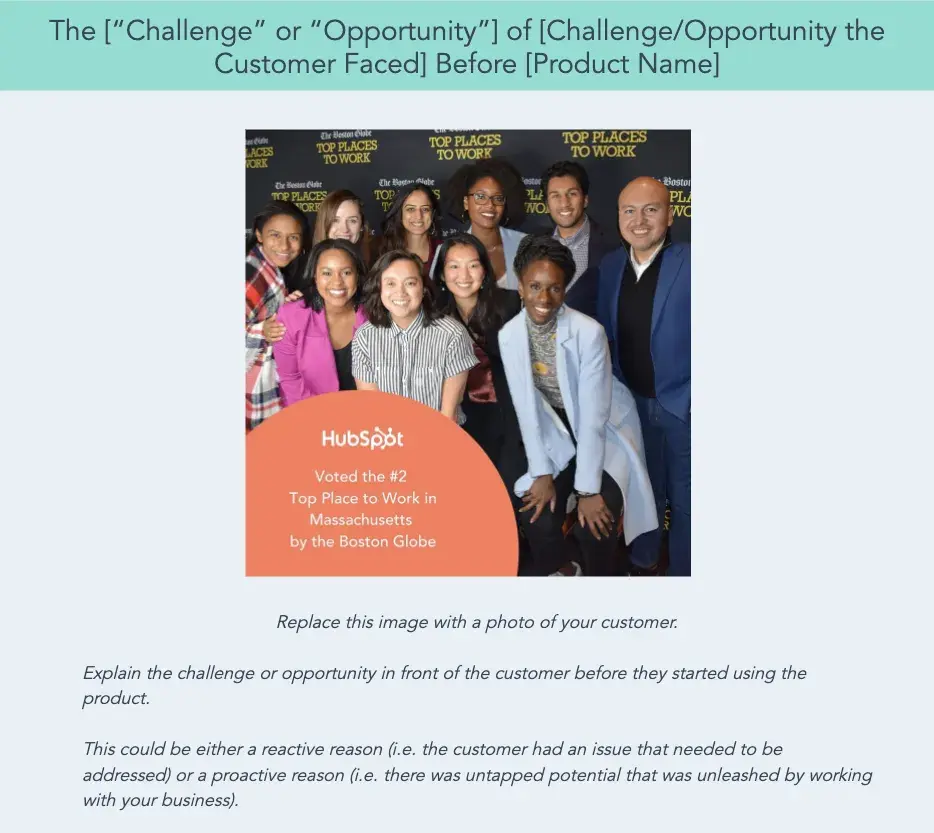


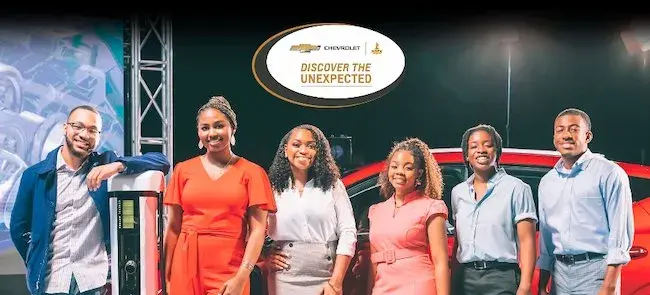
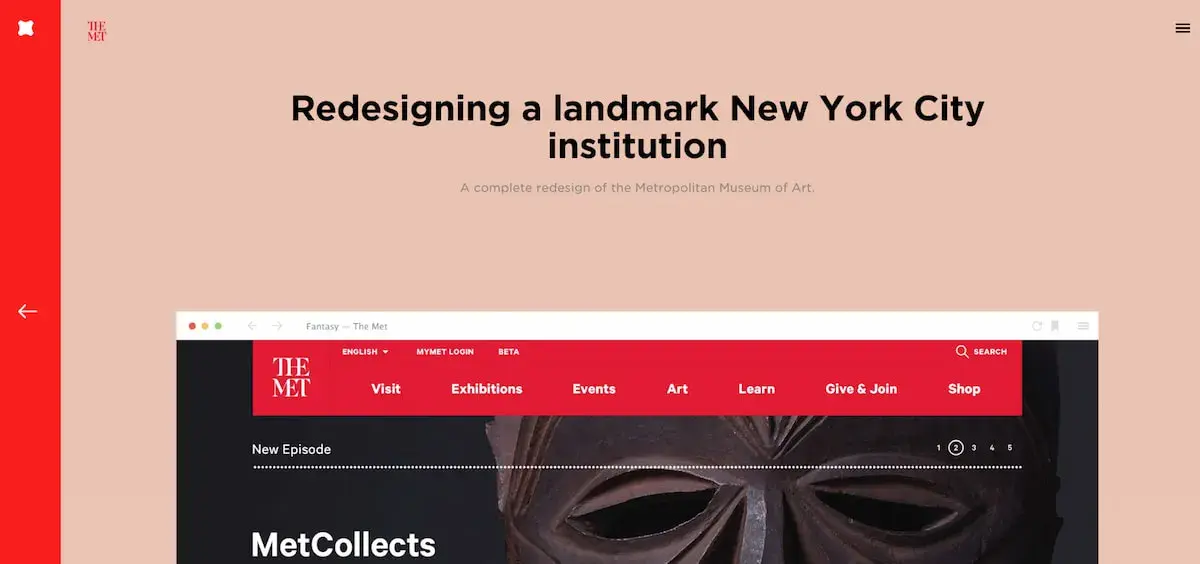
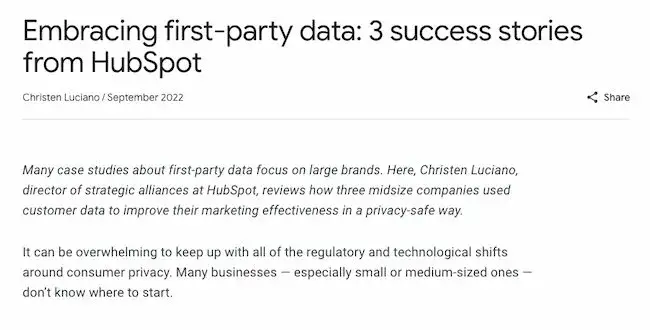
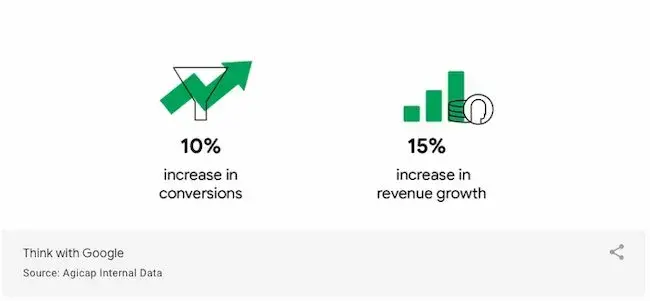

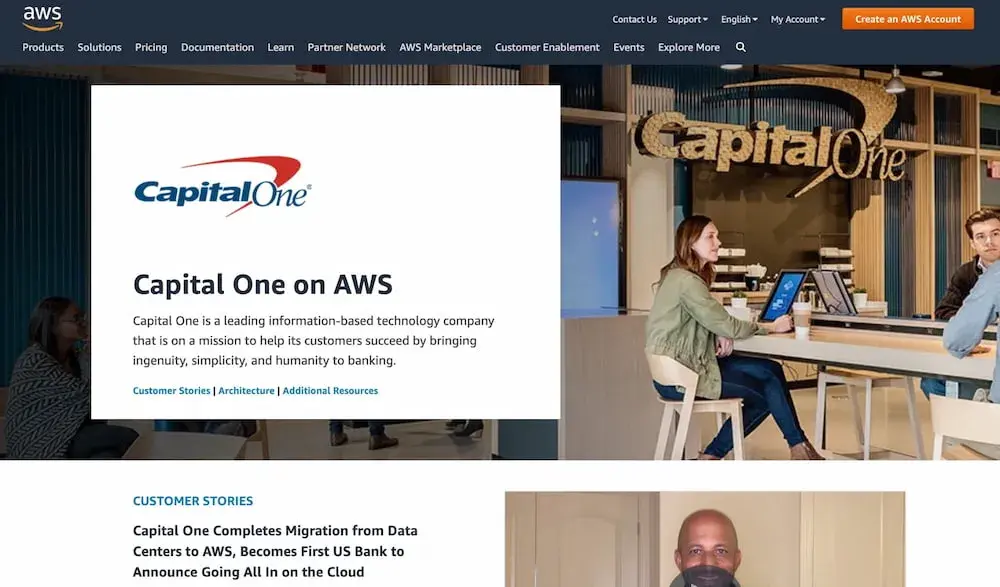
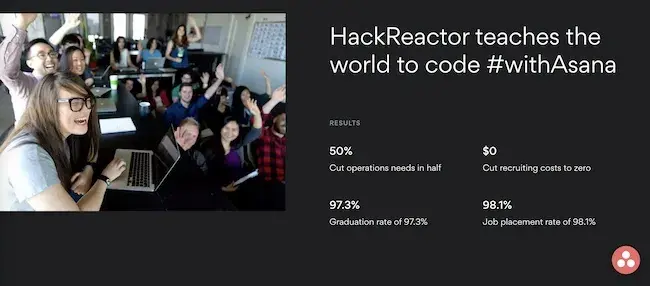
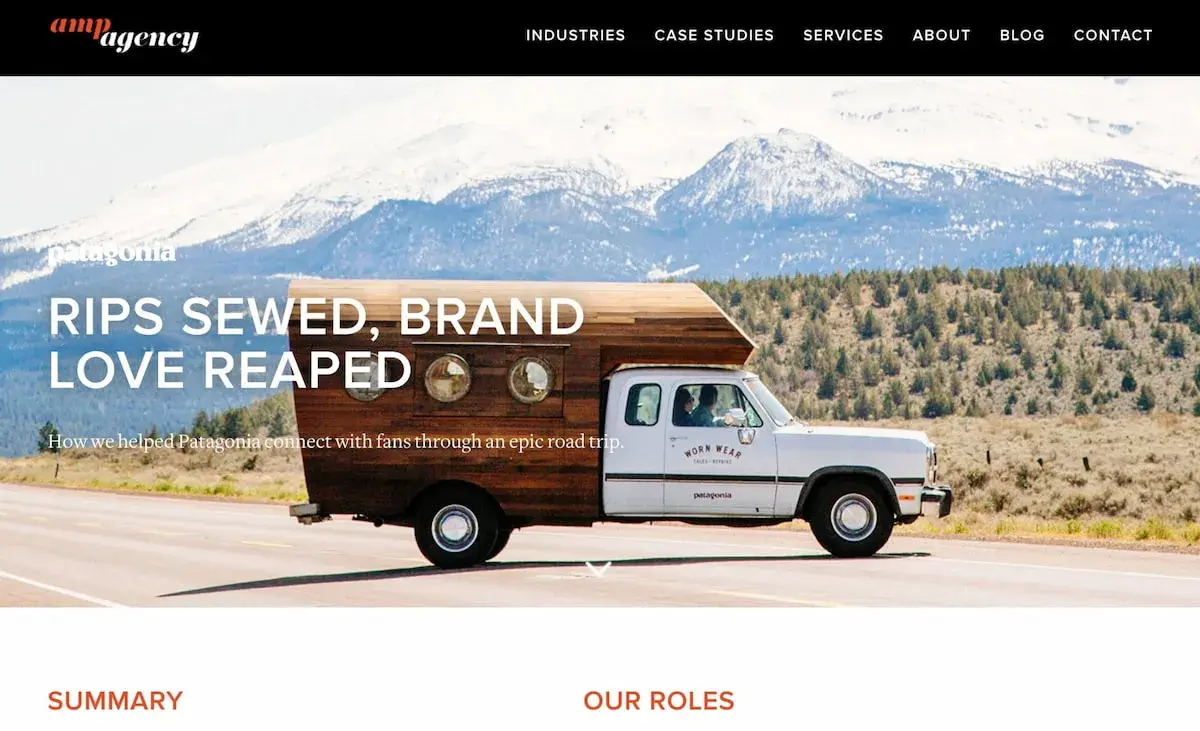

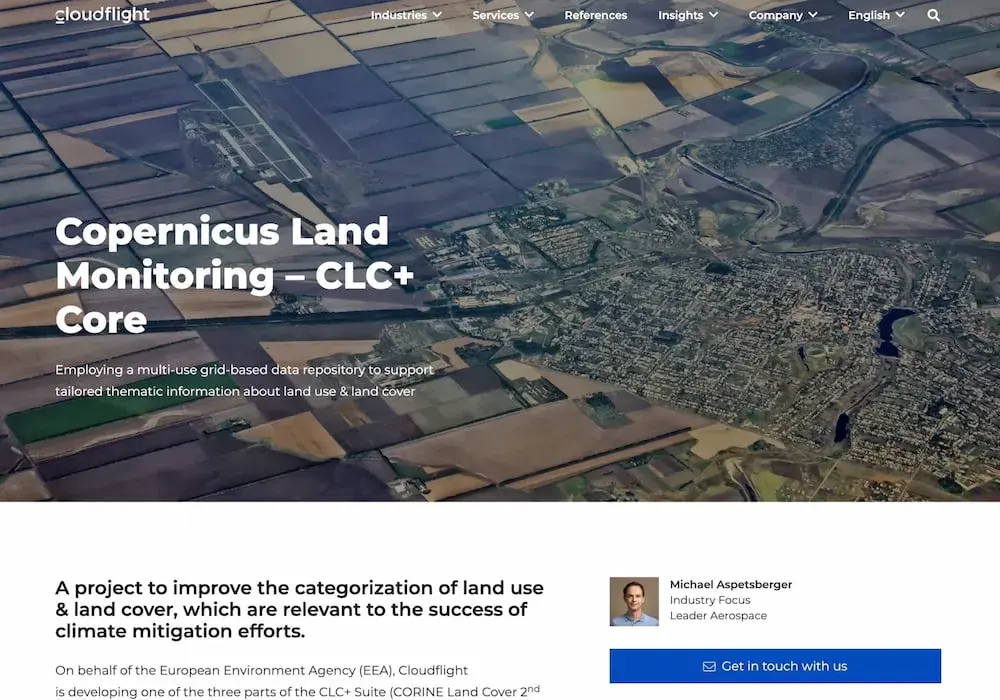
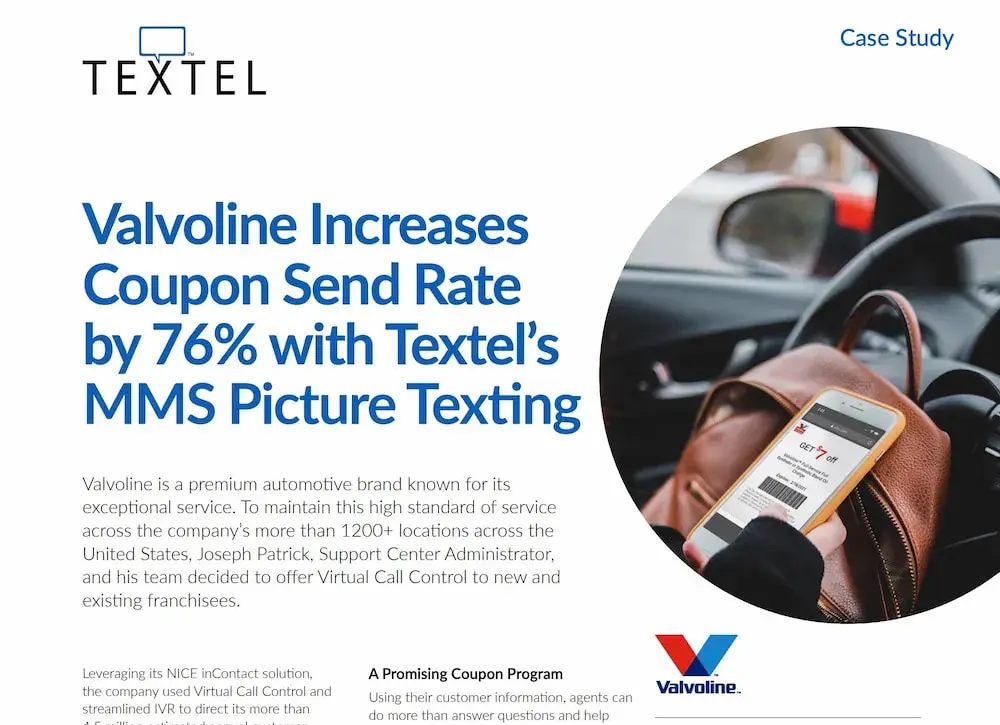
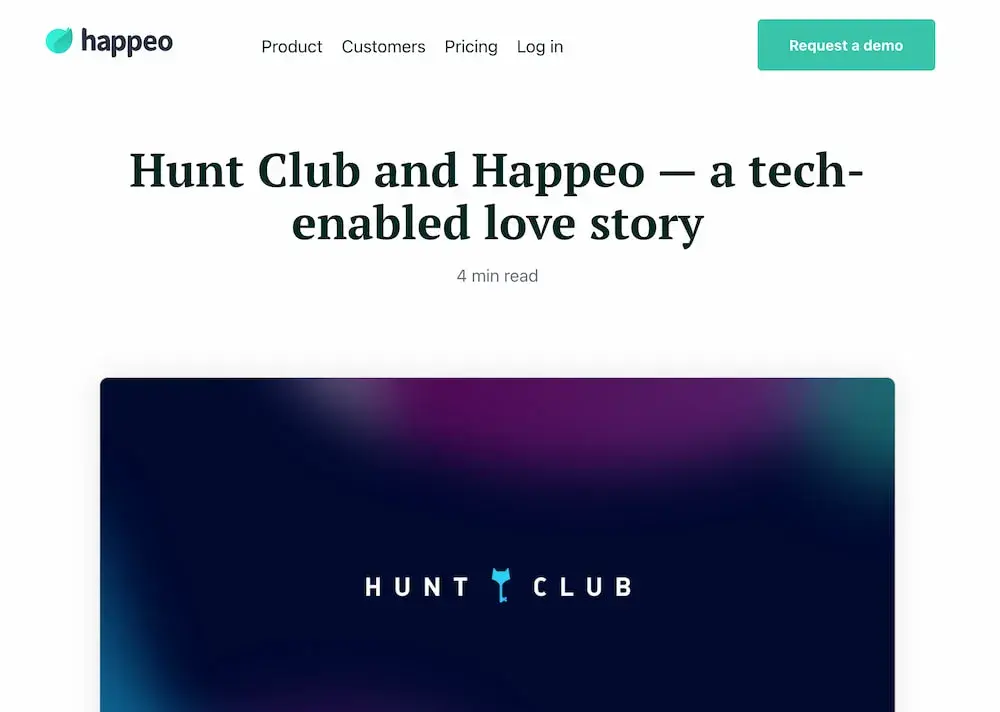
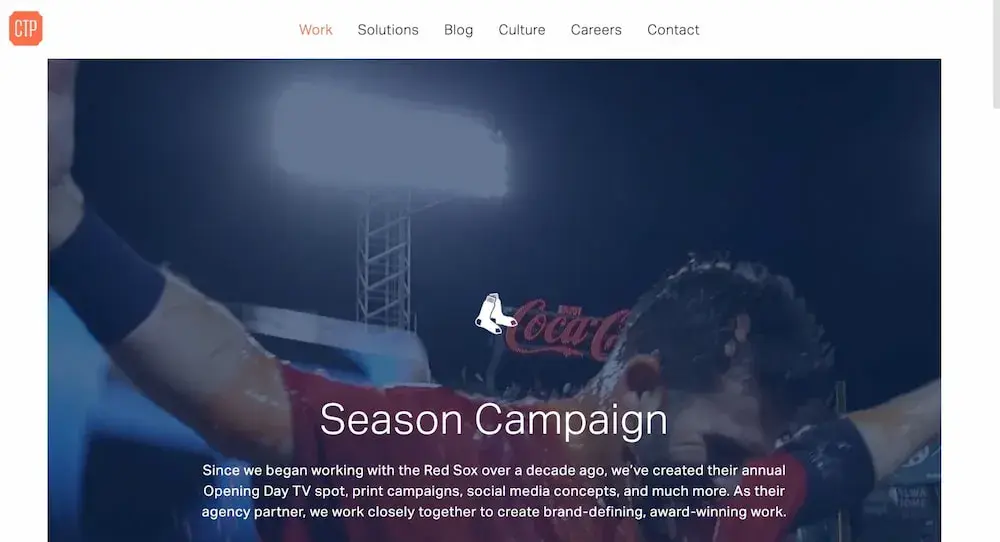
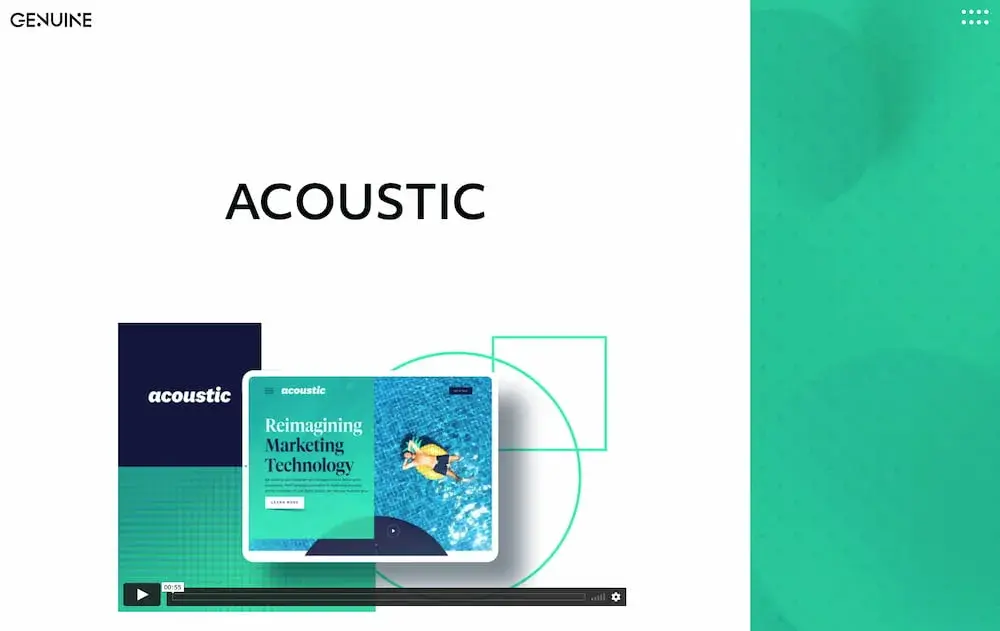
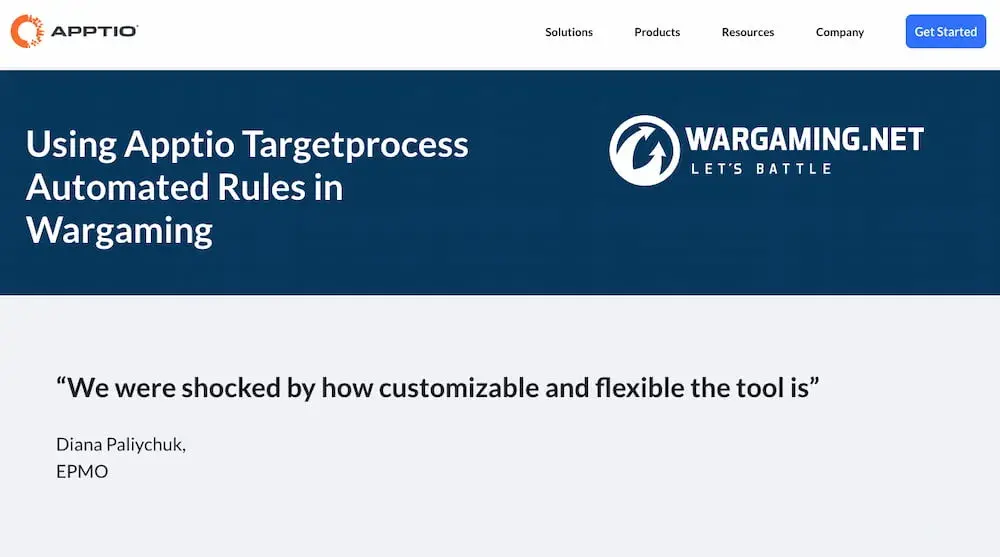
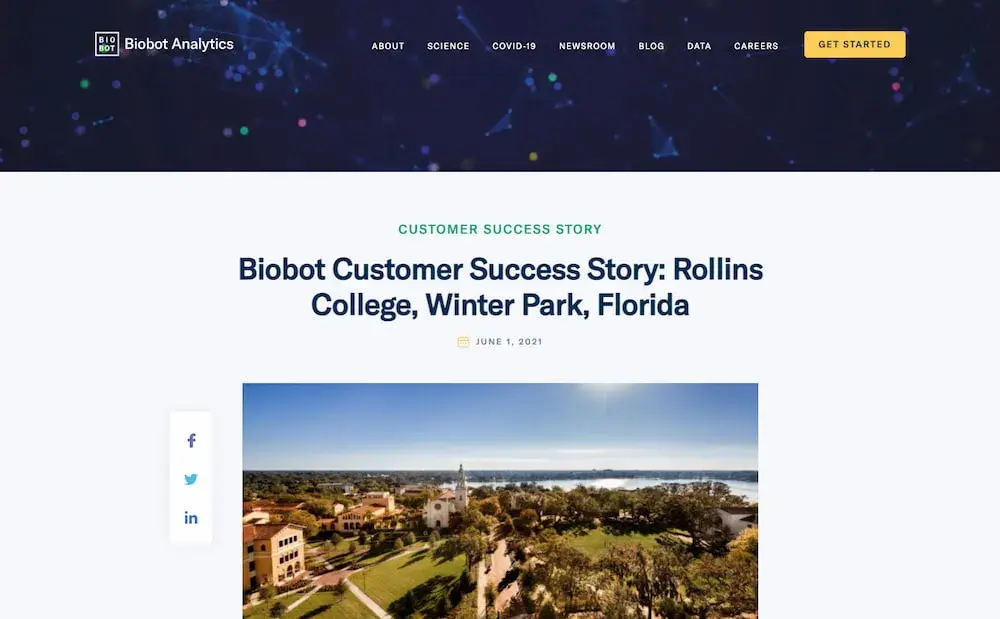

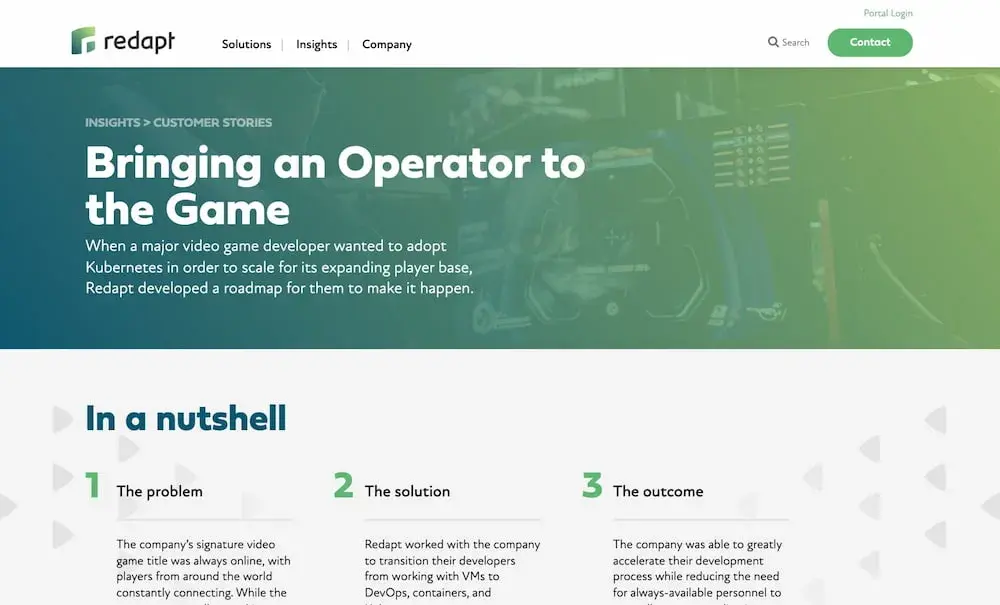
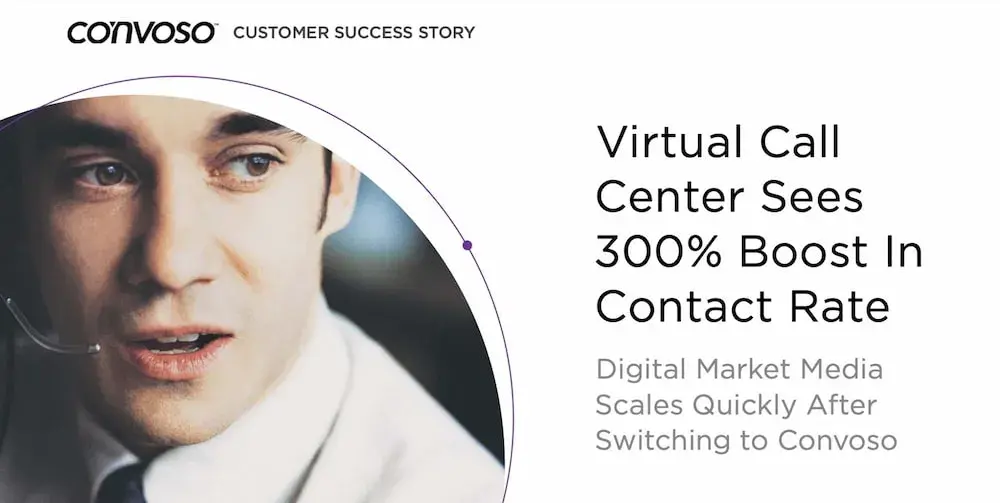
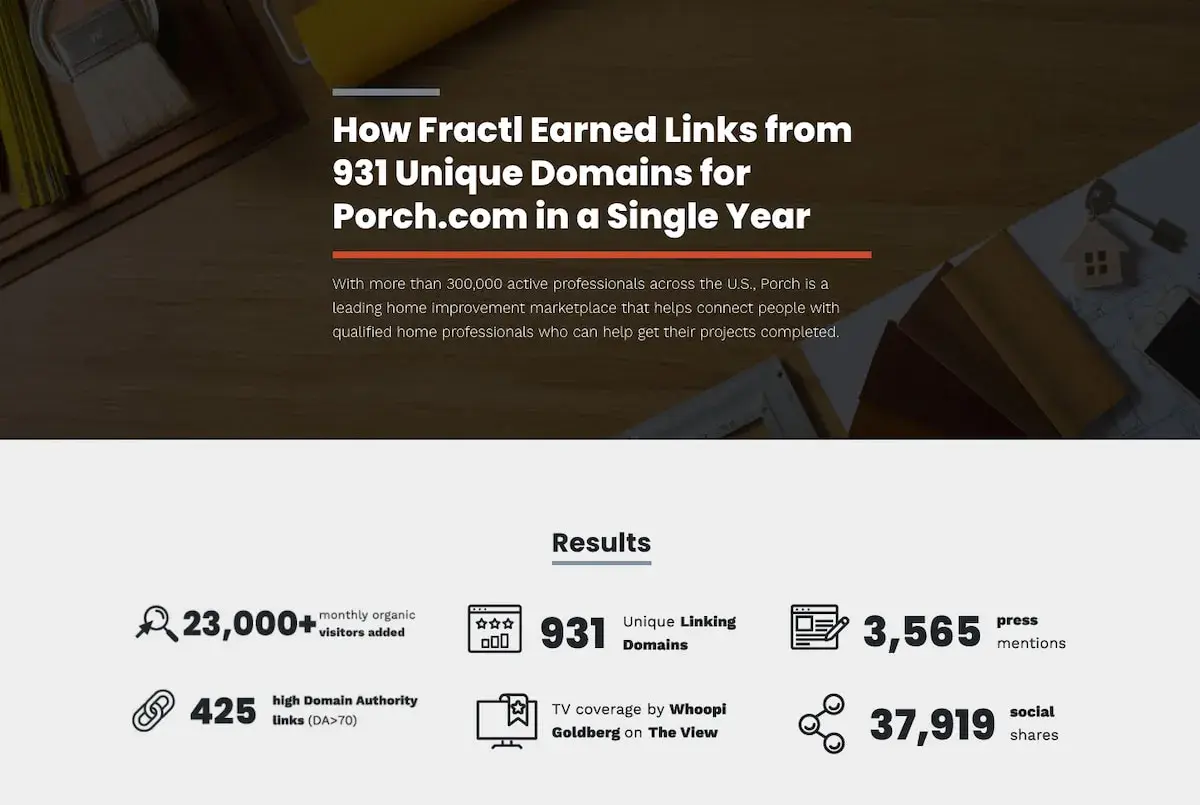
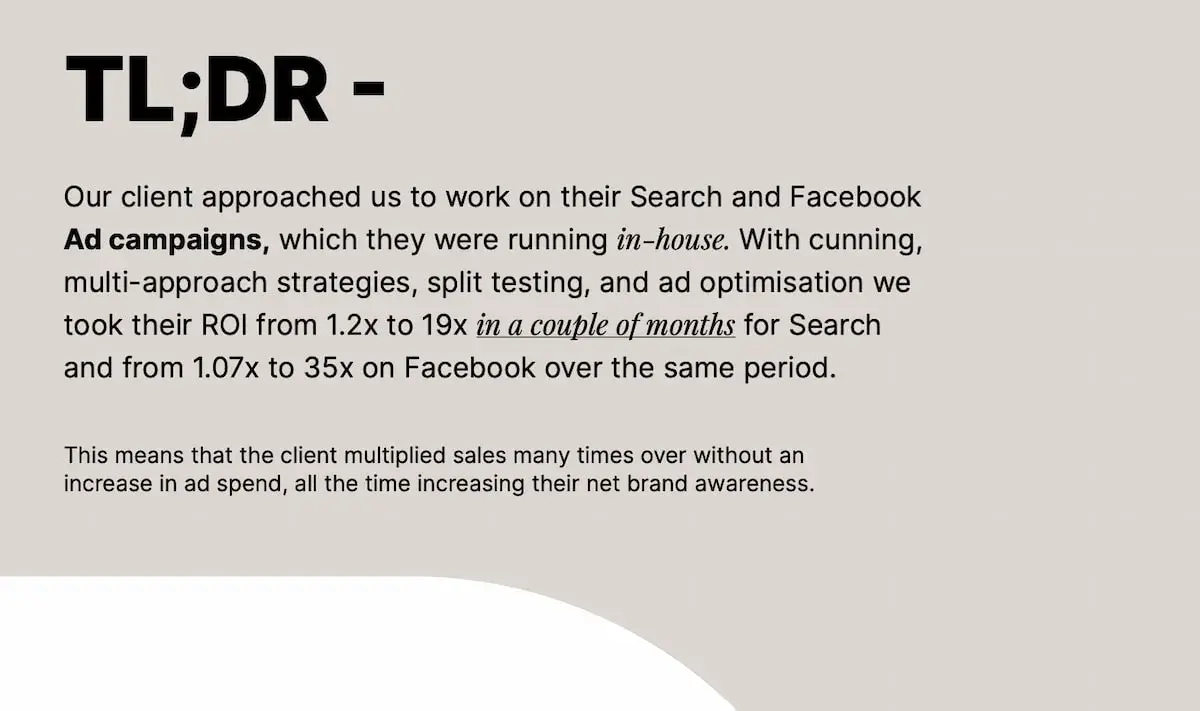

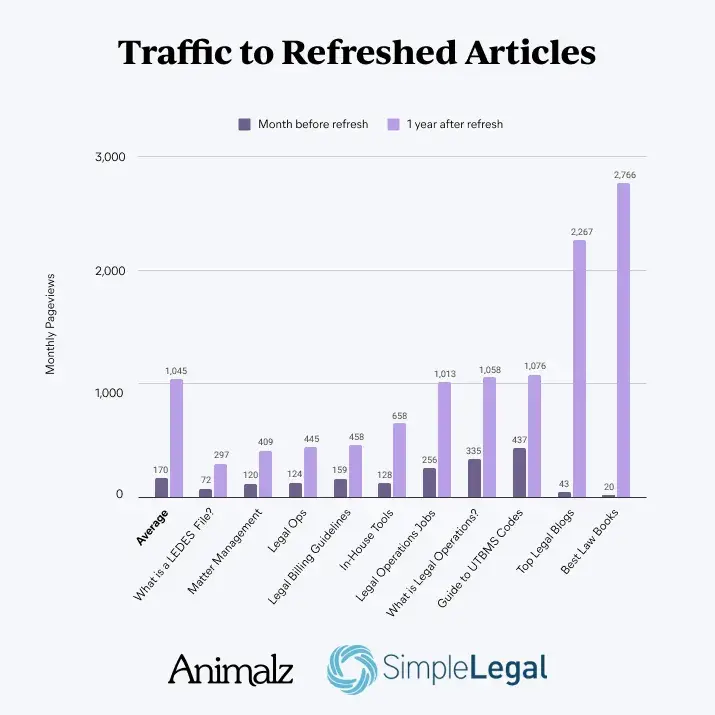
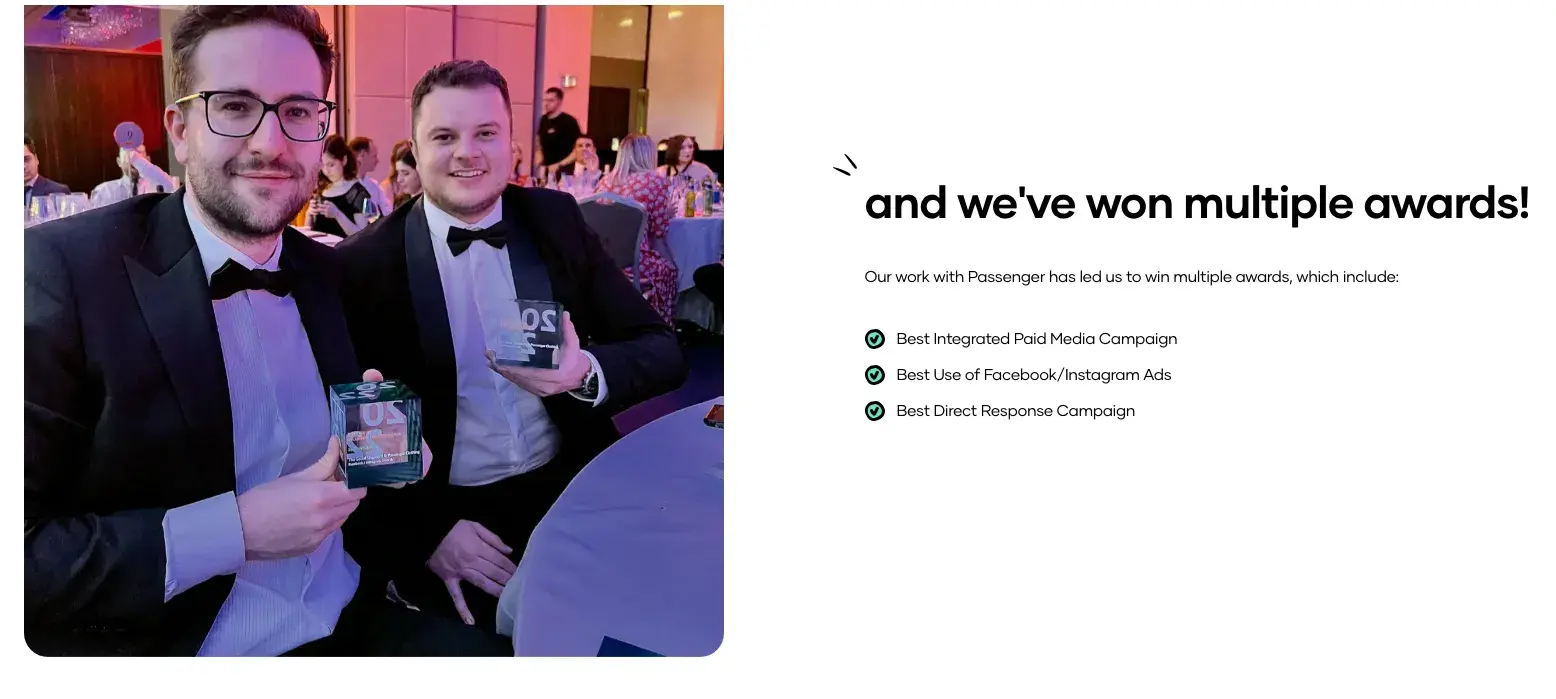
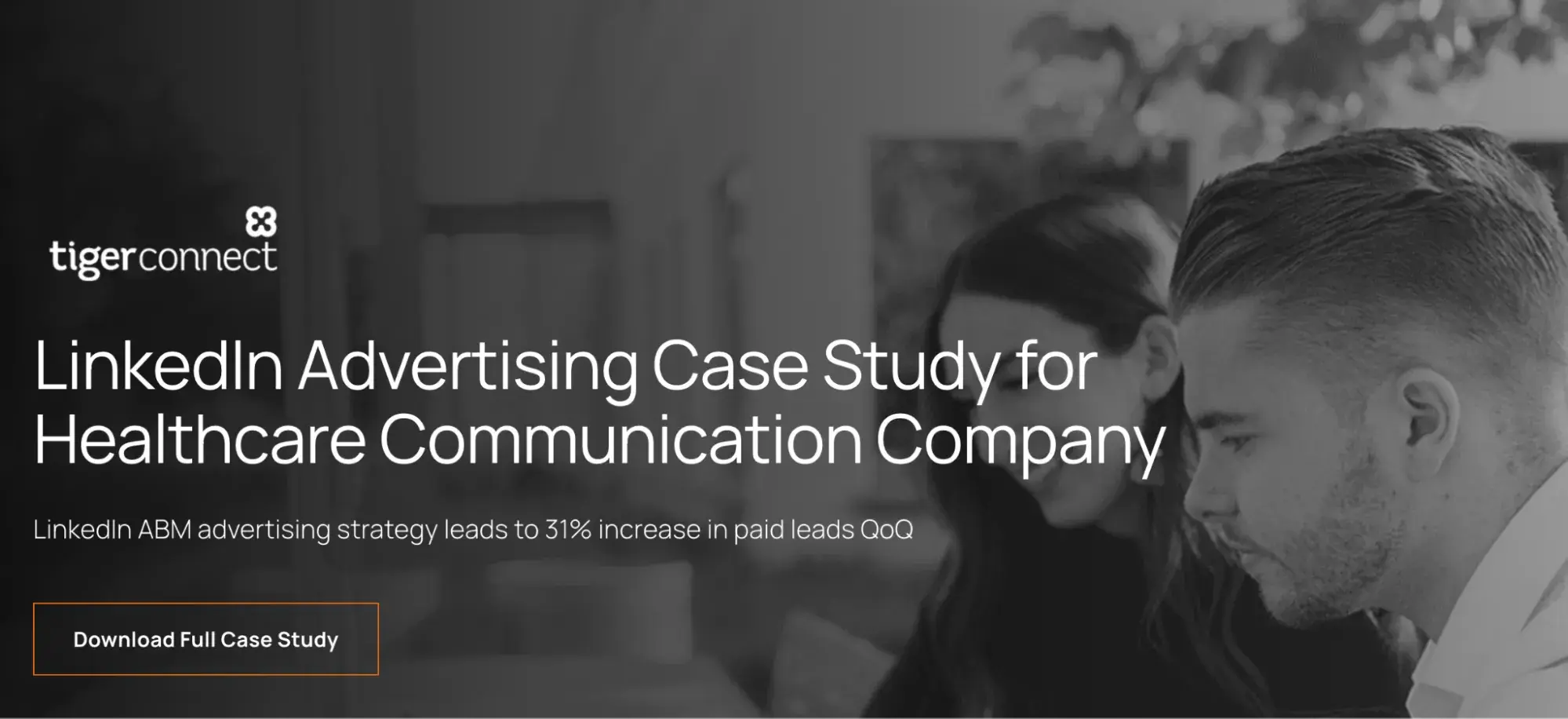
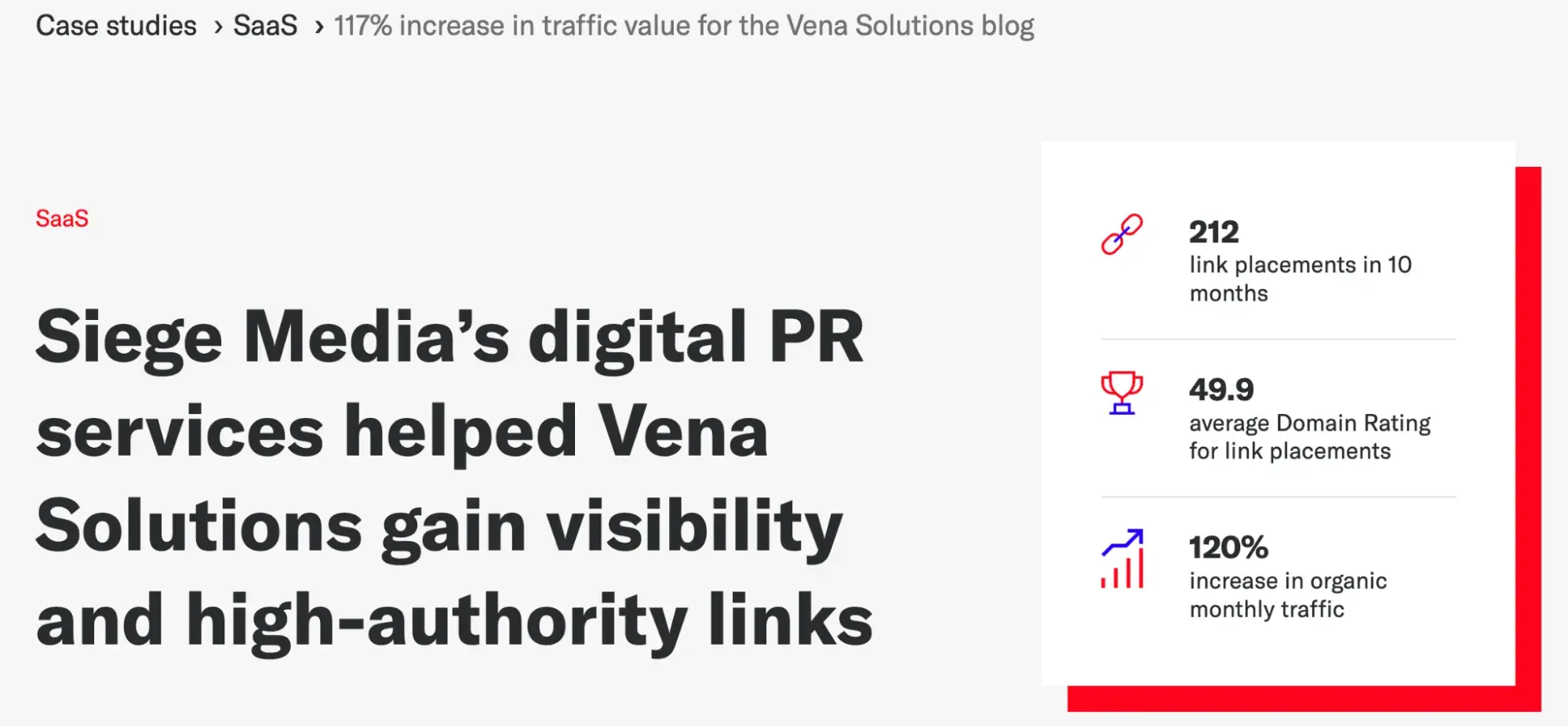

![Download Now: The Annual State of Artificial Intelligence in 2024 [Free Report]](https://no-cache.hubspot.com/cta/default/53/b72f2b25-8cc9-4642-9a1b-1e675d3d273b.png)











-1.webp?width=350&height=456&name=Copy%20of%20Copy%20of%20Track%20All%20of%20Your%20Marketing%20Data%20in%20One%20Convenient%20Place%20(17)-1.webp)




















